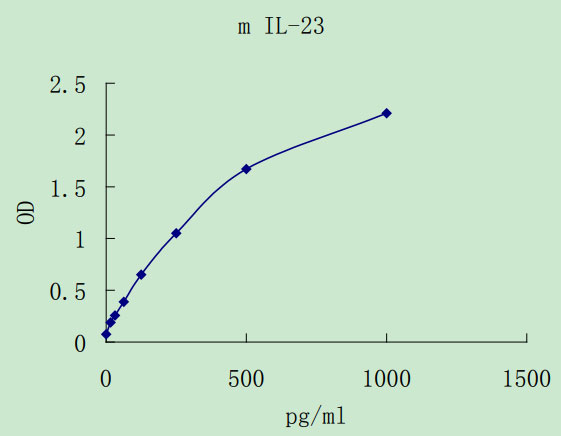Product Detail
Product NameMouse IL-23 ELISA kit
ApplicationsELISA
Species ReactivityMs
SpecificityNatural and recombinant Mouse IL-23 Ligand
Target NameMouse IL-23
Application Details
Detect Range: 0.02 - 1.0 ng/mL
Sensitivity: 7pg/mL
Sample Type: Cell culture supernatant, serum, plasma (EDTA, citrate, heparin)
Sample Volume: 20 uL
Assay Time: 3 hour
Detection method: Colorimetric
Interleukin 23 (IL-23) is a heterodimeric cytokine that is related to IL-12 (1-3). It is composed of two disulfide-linked subunits, a 19 kDa (p19) subunit that is unique to IL-23, and a 40 kDa (p40, IL-12) subunit that is shared with IL-12 (3-7). Mature mouse p19 and p40 share 88% and 92% aa sequence identity, respectively, with the corresponding rat subunits. IL-23 is produced by activated macrophages, microglia, and monocyte-derived dendritic cells in response to pathogens including certain bacteria and viruses and/or their components (3, 6). The functional IL-23 receptor complex consists of two receptor subunits, the IL-12 receptor-1 subunit (IL-12 Rβ1) and the IL-23-specific receptor subunit (IL-23 R) (7). IL-23 and IL-12 have overlapping and distinct biological activities. The IL-23 immune pathway induces the earliest recruitment of neutrophils to the site of infection, while the more classic host defense and cytotoxic response is stimulated by IL-12 (4). IL-23 has a role in the development and maintenance of a T cell subset, designated Th17, that is characterized by the production of IL-17A, IL-17F, IL-6, and TNF-α(3, 4, 8). The IL-23/IL-17 axis is an important mediator of inflammation. In mouse models, transgenic over-expression of IL-23 leads to a lethal systemic infl ammatory response (9). IL-23 eff ects on Th17 cells may also enhance the development of several models of autoimmune disease including experimental allergic encephalomyelitis (EAE), collagen-induced arthritis (CIA), colitis, and diabetes (5, 8, 10-14). IL-23 may also play a role in increased tumor growth associated with chronic inflammation (15).



 YES
YES



